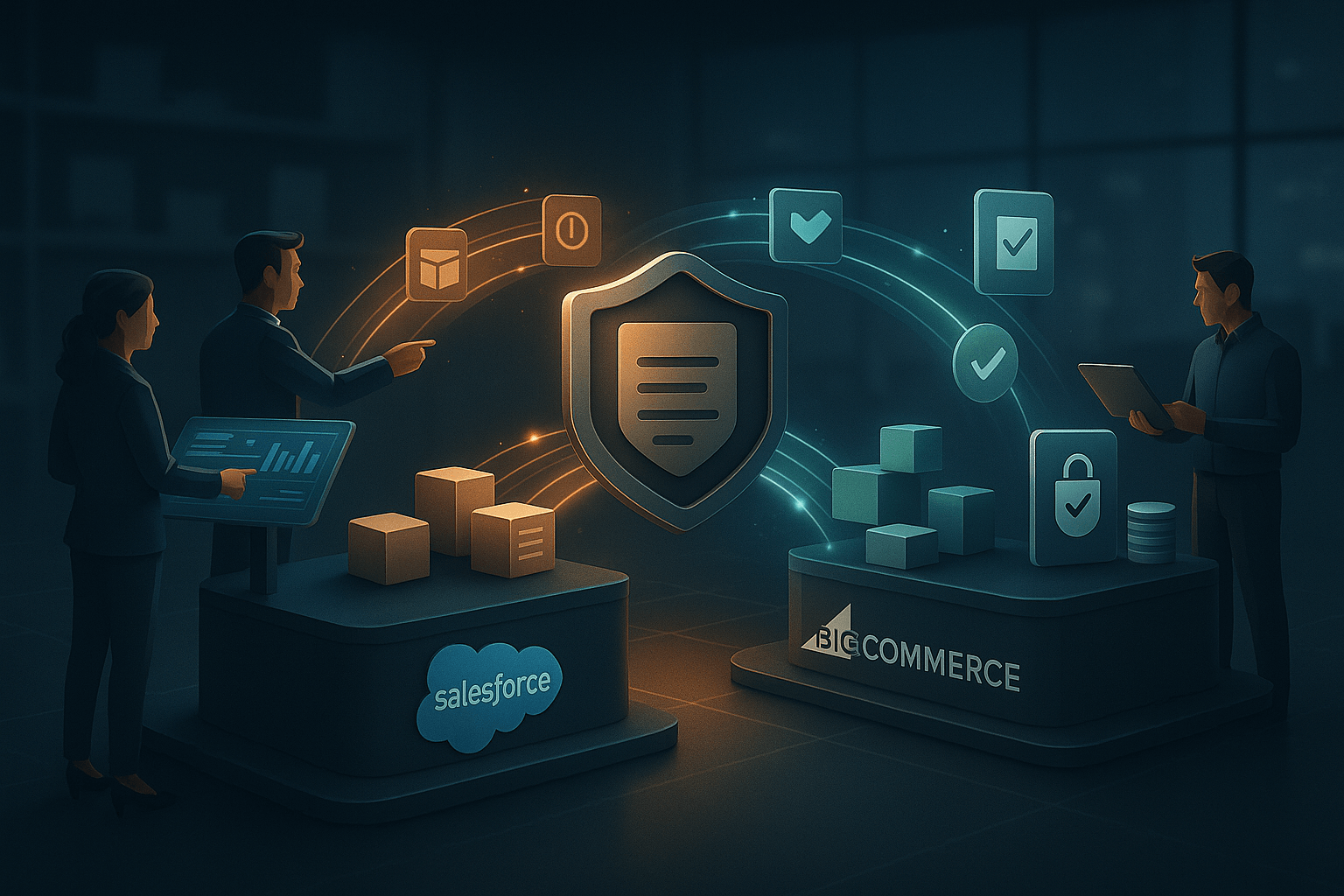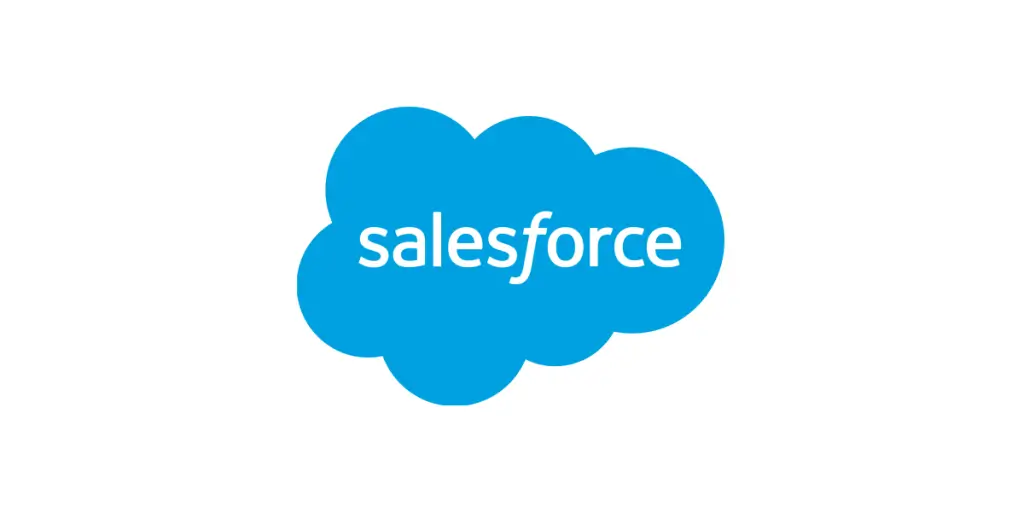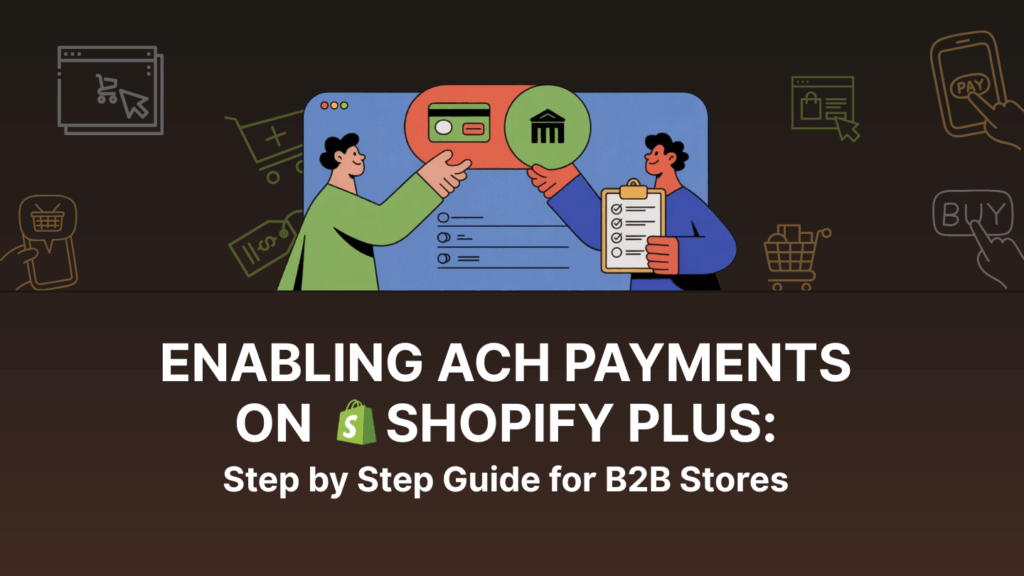The Hidden Risk in Platform Migrations
Manufacturers don’t switch commerce platforms because it’s fun. They switch because Salesforce Commerce, for all its power, eventually becomes too heavy to carry. Licensing fees pile up. Customizations bog down. Sales teams complain that it takes months to roll out changes competitors launch in weeks. Eventually, someone in the boardroom says the words everyone’s been circling: “We need something faster, leaner, easier.”
That’s usually when BigCommerce enters the conversation. It promises scalability without the bloat. A B2B suite built for contract pricing and approvals. An API-first framework that doesn’t require an army of developers just to tweak workflows. On paper, it looks like the perfect escape.
But here’s what rarely gets said out loud: most Salesforce-to-BigCommerce migrations don’t fail because the platforms are wrong. They fail because the migration team forgets what’s actually at stake. They treat it like a catalog project: move the SKUs, move the orders—without realizing the real risk lies in the business data: contracts, approvals, and pricing logic that actually hold revenue together. What gets lost in that mindset are the things buried in the current system that actually hold revenue together: contract pricing, custom approvals, account hierarchies, and buyer-specific catalogs.
When those break, the buyer doesn’t see a “technical hiccup.” They see a supplier who didn’t honor the contract. They see friction in a process that used to feel routine. They see reasons to question whether you still understand their business. And in B2B, that single moment of doubt can cost more than the entire migration project.
Why Manufacturers Move Off Salesforce Commerce
Nobody abandons Salesforce lightly. It’s the safe choice, the one everyone in the industry recognizes. But after trying to juggle many platforms, manufacturers realize Salesforce is the heaviest—and the hardest to change. But after a few years, the cracks show, and they’re not hairline; they’re structural.
The first crack is cost. Salesforce doesn’t just charge for the software. It charges for every customization, every additional module, and every consultant you need to make it do what your business actually requires. What started as a “strategic investment” slowly morphs into a tax. By the time a manufacturer is seriously considering BigCommerce, they’ve already sunk hundreds of thousands into keeping Salesforce afloat.
Then there’s the speed issue. Rolling out a change on Salesforce feels like steering a tanker. Need to adjust a pricing rule? Add a workflow? Build a customer-specific catalog? You’re staring at a three- to six-month timeline. Meanwhile, your competitors are rolling out changes in weeks. Your sales team feels it first. They’re stuck explaining delays to customers who don’t care how “complex” Salesforce is; they just know their request is still pending.
Flexibility is another sore spot. Salesforce was designed for the broadest possible set of use cases, and it shows. Manufacturers often find themselves bending their own processes just to fit the software. Approval chains that worked perfectly in the real world get broken into awkward workflows. Contract pricing has to be hacked together with custom rules that never quite stick. Instead of the system adapting to the business, the business is adapting to the system.
That’s when BigCommerce starts to look like an exit ramp. It’s not just cheaper; it’s nimbler. Its B2B suite bakes in features manufacturers had to pay consultants to duct-tape into Salesforce: contract-based pricing, buyer roles, approval workflows, and customer groups. And because it’s API-first, it integrates with ERP and CRM systems without the constant overhead.
For many manufacturers, the decision isn’t framed as “Is BigCommerce better?” It’s “Can we keep carrying Salesforce without suffocating?” By the time the question’s on the table, the answer is already clear.
Data Migration Mistakes That Break Revenue
On paper, migrations always look clean—just export, import, test, and go live. But choosing a suitable platform is only half the battle; the real risk lies in whether contracts and workflows survive the move. The slide decks make it look like a straightforward lift-and-shift. But in the real world, that thinking is exactly why so many Salesforce-to-BigCommerce projects collapse under their own weight.
The first mistake is treating the migration as a catalog move. Developers focus on getting SKUs, product descriptions, and images across. Sure, the catalog matters, but in B2B manufacturing, it’s not the catalog that keeps revenue flowing. It’s the contract terms buried deep in Salesforce: negotiated pricing tiers, discount rules, and custom approvals. When those get ignored or “mapped later,” the damage only shows up at launch, when buyers log in and discover their pricing doesn’t match the contract.
Then there’s the approval problem. Most Salesforce setups for manufacturers have some form of custom approval chain baked in: requisition → manager → finance. It’s the heartbeat of large-scale ordering. During a rushed migration, those workflows often get stripped down to something simpler because they don’t fit neatly into BigCommerce out of the box. That simplification might make the developer’s life easier, but for the customer it creates roadblocks. Orders stall, and buyers lose patience.
Customer-specific catalogs are another landmine. In Salesforce, entire account hierarchies can have their own curated catalogs, showing only the SKUs relevant to them. If migration teams skip over that nuance and just dump a universal catalog into BigCommerce, buyers suddenly see products they’re not authorized to purchase. That’s not confusing; it undermines the integrity of the relationship.
And finally, sales team visibility often takes a hit. In Salesforce, reps are used to seeing contract terms, order history, and account-level activity in one place. After migration, if that visibility isn’t rebuilt inside BigCommerce (or synced tightly through integrations), the sales team is flying blind. They can’t answer buyer questions. They can’t step in when orders get stuck. They’re forced to scramble, and customers can smell it.
These failures don’t usually show up in the project plan. They only surface on launch day, when the customer logs in and the cracks become real. That’s why most migrations don’t fail technically, they fail because the people running them forget that what’s being moved isn’t just data. It’s the revenue system.
The Real Cost of Broken Pricing and Workflows
When a migration drops a product image or a category link, it’s an inconvenience. When it drops a contract price or breaks an approval chain, it’s a crisis. The difference is that one can be fixed quietly in the background. The other plays out in front of your most important customers.
Start with pricing. A procurement officer logs in, expects to see the rates they’ve negotiated, and instead sees retail prices. To your internal team, it looks like a data error. To the customer, it looks like a breach of contract pricing. And procurement officers don’t shrug off breaches. They escalate. At best, you’re on the phone explaining yourself. At worst, orders stop cold while they reassess the relationship.
Approval workflows create the same kind of damage. In Salesforce, a request might flow seamlessly from requisitioner to manager to finance. If that chain breaks in BigCommerce, orders just sit. Nobody approves, nobody fulfills, and buyers are left chasing down answers. In large organizations, even a few days of disruption can cause projects to stall or production schedules to slip.
Margins erode quickly too. When pricing rules don’t survive the migration, you don’t just lose a smooth transition—you force sales reps into damage control. They start applying manual discounts or overriding orders to smooth things over. It keeps the account alive, but it eats into profitability. And once customers see you improvising on price, it’s hard to convince them the system is stable again.
The ripple effect is brutal. Reps spend their time apologizing instead of selling. Customers quietly test the waters with competitors. Deals that should be straightforward get bogged down in mistrust. What looked like a technology project becomes a revenue leak.
This is the part migration slide decks never show. You don’t just risk downtime. You risk credibility. And once a customer doubts whether you can honor the fundamentals—pricing, approvals, catalogs—that doubt doesn’t go away easily.
What Has to Be Preserved in a Successful Migration
Every migration involves trade-offs. Maybe a widget looks different, maybe a search filter needs retraining, or maybe some design element doesn’t make the cut. Those are tolerable. What’s not negotiable are the core pieces of how your customers buy. If even one of these breaks, the relationship cracks.
Contract Pricing Tiers
The entire business model of industrial manufacturing rests on negotiated rates. Some accounts get tiered discounts; others have fixed pricing locked in for years. Those numbers aren’t suggestions—they’re contractual obligations. A migration has to carry them across precisely, with zero room for “close enough.”
Approval Chains
Big orders don’t move without approvals. A requisitioner adds items, a manager signs off, and finance gives the final green light. Salesforce often has these flows customized to the buyer’s internal rules. If BigCommerce doesn’t preserve them, orders stall in limbo. Preserving approvals isn’t a technical detail; it’s how your customers manage risk.
Customer-Specific Catalogs
Not every buyer should see every SKU. Some contracts limit access to specific products or bundle agreements. A successful migration has to replicate those filtered catalogs so buyers log in and see only what’s relevant to them. If they suddenly see products outside their contract, or worse, can’t find the ones they rely on—you’ve introduced confusion into a process that demands clarity.
Account Hierarchies and Buyer Roles
Enterprise accounts aren’t single logins. They’re hierarchies: corporate offices, regional branches, department buyers, approvers, and finance. Salesforce can reflect that complexity, and BigCommerce can too, but only if it’s configured deliberately. Preserving these structures is what keeps large buyers functioning without disruption.
Sales Team Visibility
Your reps can’t protect margins or troubleshoot accounts if they’re blind. They need to see pricing, order history, and buyer activity the way they did in Salesforce. BigCommerce can surface much of this directly, but full 360° visibility usually comes from syncing with your CRM or ERP. Stripping away that visibility during migration turns reps from advisors into guessers. A proper migration ensures sales has the same insight inside BigCommerce.
In other words, you can compromise on design, and you can delay a feature, but you cannot compromise here. These elements are the scaffolding of trust between you and your customers. Remove one, and the whole structure wobbles.
The Migration Process: Blueprint for Protecting Revenue Systems
The difference between a migration that quietly succeeds and one that burns contracts to the ground isn’t luck. It’s a process. Manufacturers who treat this like a catalog move almost always stumble. The ones who make it through intact follow a blueprint that keeps revenue front and center.
Audit Everything That Touches Revenue
Before you move a single SKU, you need a full inventory of contracts, pricing tiers, approval flows, catalogs, and account hierarchies. This isn’t a data export—it’s a map of how your customers actually buy. If something feels “too messy to document,” that’s exactly the kind of detail that will blow up later if ignored.
Map Salesforce Logic to BigCommerce Equivalents
BigCommerce’s B2B Suite can handle most of what Salesforce does—price lists for contract tiers, buyer roles for approval flows, and customer groups for catalogs. But they don’t look the same on the surface. Migration teams need to translate, not just copy. A Salesforce discount table doesn’t become a BigCommerce price list automatically—it has to be restructured so it works natively.
Extend Where the Gaps Exist
Not every workflow has a one-to-one equivalent. That’s where APIs and middleware come in. Approval chains with more than two or three steps, complex account hierarchies, and ERP-linked catalogs—these may need custom extensions. The goal isn’t to force the buyer into a new process. It’s to replicate the one they already trust.
Pilot With Your Most Demanding Accounts
Don’t wait until launch day to find out what broke. Bring in a handful of top accounts early, replicate their contracts and workflows inside the target platform, and let them test it before launch. If the procurement officer can log in, build an order, see their pricing, and run it through approvals without calling your sales rep, you’re on the right track.
Train Sales Teams Before Go-Live
Too many migrations launch with sales teams in the dark. The day buyers start calling, reps should already know how to check contracts, approvals, and order history in BigCommerce. If your own team doesn’t trust the system, your customers won’t either.
The guiding principle is simple: a successful migration is invisible to the buyer. If they log in on Monday after launch and place their usual order without noticing anything different, you’ve won. If they notice—because pricing is wrong, approvals don’t work, or catalogs look different—you’ve failed.
Why BigCommerce Is Built for This
BigCommerce didn’t start as a B2B platform. For years, it was known as a flexible, API-driven alternative to legacy ecommerce systems. But over the past few years, it has leaned hard into B2B—and the result is a suite of features that, if implemented correctly, can handle almost everything manufacturers relied on Salesforce for.
Price lists replace messy discount tables. Customer groups allow you to filter catalogs down to the account level. For especially complex account hierarchies, additional API logic can layer on the granularity manufacturers are used to in Salesforce. Buyer roles replicate approval hierarchies out of the box, and for manufacturers with multi-step chains that go beyond two or three approvals, BigCommerce’s API-first framework makes it straightforward to extend those rules. And because it’s API-first, BigCommerce can connect cleanly into ERP and CRM systems—keeping contract data synchronized instead of floating in silos.
The other advantage is agility. Salesforce requires armies of consultants and long lead times to make even small changes. BigCommerce, by design, is lighter. That means manufacturers can roll out adjustments in weeks instead of quarters. For sales teams who are tired of telling customers “we’re working on it,” that agility is the difference between frustration and momentum.
But here’s the catch: BigCommerce doesn’t save you from a bad migration. It gives you the raw materials, but if you treat the project like a catalog dump, you’ll still break contracts, approvals, and sales visibility. The platform can do it, but it won’t do it for you.
This is why some migrations into BigCommerce soar and others implode. The difference isn’t the platform. It’s whether the team moving you in respects the complexity of your revenue systems and takes the time to rebuild them correctly.
Done right, BigCommerce doesn’t just match Salesforce’s functionality. It gives manufacturers room to grow without dragging a heavy, expensive system behind them. Done wrong, it becomes just another failed experiment—another reason for customers to doubt your ability to keep promises.
A Tale of Two Migrations
I worked with a manufacturer last year that had about two hundred active contracts on the books. Each contract came with its own pricing tiers, and every big order ran through a three-step approval chain on the customer’s side. On paper, their Salesforce-to-BigCommerce migration looked simple: move the catalog, move the orders, and call it a win.
Here’s how it played out the first time.
The migration team did what most do—they focused on products. SKUs, categories, and order history. The rest, they figured, could be “cleaned up later.” But later never came. Contract pricing got flattened into a handful of generic rules. Approval workflows were trimmed down to fit whatever was easiest to configure in BigCommerce. And customer-specific catalogs? Ignored.
Launch day was brutal. A procurement officer logged in and immediately flagged that their negotiated rates had vanished. Another tried to push an order through but got stuck because the manager-level approval was gone. Others saw SKUs they weren’t even supposed to have access to. Within forty-eight hours, the sales team was in full triage mode—issuing manual discounts, apologizing, and keying in orders themselves just to keep contracts alive. The system wasn’t saving time or money. It was draining both.
Now imagine the same company approaching it differently. Before touching a single product record, they took inventory of everything that actually kept the revenue flowing—every contract, every approval step, every catalog rule. Instead of “flattening” those details, they rebuilt them carefully in BigCommerce: price lists instead of generic discounts, buyer roles to mirror approval hierarchies, and customer groups to control catalog visibility. For the gaps BigCommerce didn’t cover directly, they leaned on APIs to extend it.
And here’s the difference: when they went live, customers didn’t notice a thing. Procurement officers logged in Monday morning and ordered the same way they had Friday afternoon. Prices matched. Approvals flowed. Catalogs looked familiar. Nothing felt broken. For the customer, it wasn’t a “new system.” It was business as usual—only faster. For the sales team, it wasn’t a fire drill. It was quiet, steady revenue.
The lesson is simple: one approach treated the migration as moving data. The other treated it as protecting contracts. Only one of them kept the business intact.
The Sales Team’s Role in Migration Success
Most failed migrations have one thing in common: they were run entirely by IT. The developers map data, the project managers track timelines, and the sales team gets a quick demo a week before launch—if they’re lucky. That’s a mistake manufacturers can’t afford to repeat.
Sales knows the messy reality better than anyone. They know which customers negotiated oddball discounts years ago that still have to be honored. They know which accounts use three approval steps instead of two or which ones rely on a custom catalog that nobody outside the rep and the buyer even remembers exists. None of that nuance lives cleanly in a Salesforce export. It lives in the heads of the people working the accounts.
If you leave sales out of the migration, those details get lost. And when they resurface, it’s not in a test environment—it’s when a procurement officer is staring at the wrong price and your rep is on the phone explaining why the system doesn’t match the contract. That’s how trust evaporates.
The flipside is just as true. When sales is pulled in early, they become the safeguard. They can point out the quirks that would never show up in a spreadsheet. They can test accounts during pilots and catch errors before buyers do. And when go-live finally happens, they’re confident enough in the system to stand behind it with customers.
Protecting margins isn’t just about clean data—it’s about making sure the people who actually carry the relationships have a voice in how the system is rebuilt. Sales isn’t a “user group” to be trained after the fact. They’re the front line, and if they aren’t involved from the start, no amount of technical precision will save you.
Turning Migration Into a Competitive Advantage
In manufacturing, most companies stumble through migrations. Everyone in the industry has seen it happen: a new platform launches, contracts get scrambled, customers complain, and for months the sales team is cleaning up the fallout. Procurement officers don’t forget those mistakes. They keep a mental note: this supplier is hard to work with.
That’s why getting it right carries so much weight. If you can pull off a Salesforce-to-BigCommerce migration without breaking a single contract or slowing a single approval, you’re sending a message to your customers: we value your trust more than we value speed. That’s not just technical success—that’s relationship capital.
Competitors rarely manage that. Most try to shortcut the process, and their customers feel the pain. If your buyers log in the day after launch and discover everything works exactly as it did before—same pricing, same workflows, same catalogs—you’ve set yourself apart. To procurement, you become the supplier who can innovate without creating risk.
And that advantage compounds. Sales reps stop apologizing for broken workflows and start talking about growth. Customers who’ve seen other suppliers fumble their migrations start shifting more business your way, because you’ve proven you can modernize without disruption. Even prospects take notice. In an industry where word travels fast, being the company that “got migration right” is a reputation few can claim.
Handled poorly, migration is a liability. Handled correctly, it becomes a competitive moat. You don’t just protect revenue—you strengthen your position in the market by showing customers and competitors alike that your operations are as reliable as your contracts.
Salesforce to BigCommerce Success Pack
Contract Preservation Audit (Pre-Migration Must)
Purpose: Identify revenue-critical rules before touching SKUs.
How to Use: Run this audit with both IT and sales—don’t leave it to developers alone.
| Revenue Anchor | Audit Question | Status |
| Contract Pricing Tiers | Have all negotiated rates been documented and mapped? | ☐ |
| Approval Chains | Do we know the exact buyer → manager → finance steps for top accounts? | ☐ |
| Customer-Specific Catalogs | Have filtered catalogs per account been captured? | ☐ |
| Account Hierarchies | Are buyer roles and branch-level permissions mapped? | ☐ |
| Sales Rep Visibility | Will reps still see contracts, orders, and buyer activity at go-live? | ☐ |
Salesforce → BigCommerce Logic Map
Purpose: Translate Salesforce complexity into BigCommerce’s B2B Suite.
How to Use: Use this as your “translation key” to avoid flattening details.
| Salesforce Feature | BigCommerce Equivalent | Notes |
| Discount Tables | Price Lists | Must preserve contract rates exactly |
| Approval Rules | Buyer Roles + Approval Workflows | Extend via API for >2 steps |
| Account Catalogs | Customer Groups | Ensure only contract SKUs are visible |
| Account Hierarchies | Roles + Groups | Rebuild with ERP/CRM integration |
| Reps’ Account View | BC + CRM Integration | Don’t strip sales visibility |
Pilot & Testing Sequence
Purpose: Catch trust-killing errors before buyers do.
How to Use: Always test with your most demanding accounts first.
| Step | What to Test | Owner | Status |
| Pricing Match | Do contract prices display correctly? | Sales Ops | ☐ |
| Workflow Integrity | Do approvals flow end-to-end? | IT / Sales | ☐ |
| Catalog Accuracy | Do buyers only see authorized SKUs? | Account Manager | ☐ |
| Rep Visibility | Can reps answer “what’s my price?” instantly? | Sales | ☐ |
| Live Simulation | Have customers run a real order? | Pilot Buyer | ☐ |
Post-Migration Success Metrics
Purpose: Ensure migration protected—not damaged—revenue.
How to Use: Track these monthly for 3–6 months after launch.
| Metric | Baseline | Month 1 | Month 3 | Target |
| % Orders with Correct Pricing | X% | 100% | ||
| Approval Workflow Errors | X | 0 | ||
| Catalog Confusion Tickets | X | ↓ 90% | ||
| Sales Rep “Manual Fixes” | X | ↓ 80% | ||
| Buyer Satisfaction (Top 20 Accts) | X/10 | +2 pts |
Protecting Contracts, Preserving Trust
Switching platforms isn’t optional forever. Sooner or later, Salesforce becomes too heavy, too expensive, too slow. BigCommerce is the logical next step for manufacturers who need speed and flexibility without sacrificing B2B functionality. But the migration itself—that’s where companies lose contracts, margins, and credibility.
Because here’s the truth: you don’t lose customers because your new site loads a little slower. You lose them because their pricing disappeared. Because their approval chains broke. Because they logged in on Monday morning, and the system they’ve trusted for years suddenly stopped working the way they need it to.
That’s why a Salesforce-to-BigCommerce migration isn’t a technology project—it’s a contract preservation project. Done wrong, it bleeds revenue. Done right, your customers don’t even notice the switch. They keep buying, your sales team keeps selling, and the trust you’ve built over years stays intact.
If you’re preparing to make this move, contact us before migration begins. We’ll dig into your Salesforce setup, uncover where contract terms and workflows are most at risk, and map exactly how to carry them into BigCommerce without disruption.
Because at the end of the day, migration success isn’t measured in SKUs moved or pages migrated. It’s measured in whether your customers can still order without friction and whether they still trust you enough to sign the next contract.












